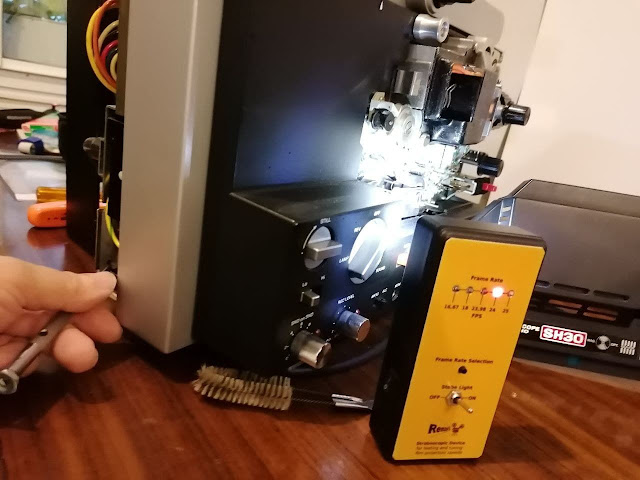One of the best investments that can be made in our "Super-8 universe" (and that, in addition, it can also be used for 16 mm and 35 mm too), at a very affordable price (less than the cost of 3 cartridges of Kodak Ektachrome in Super-8!), is the Renzo´ Stroboscopic Device for fine tune of motion pictures projectors.
Film cine projectors have two types of motors: AC (acronym of Alternating Current) and DC (Direct Current). Those of alternating current (like the Eumig machines made in Austria or the Fumeo), the motor go at a fixed speed, stable by the frequency of the mains, which can be altered by mechanical procedures. Direct current DC are low voltage motors in which speed can be controlled electronically. These types of DC motors are those found in most Super-8 projectors manufactured after 1975 (with the exceptions already mentioned, and some others prior 1975).
With Renzo' Stroboscopic Device, you can reliably check whether the projector is running at the correct speed, something that I had to do "by ear" before. Renzo's Device is used to adjust the correct speed to just 16.67, 18, 23.98, 24 and 25 f.p.s.. The device has two switches, one to select the speed (which is marked by a diode) and the other to activate the strobe light. With this light, it is necessary to aim at the toothed roller of the projector: moving the fine speed adjustment, when the teeth of the wheel visually seems that they are immobile, then, is when the speed is correctly adjusted to the chosen value.
All projectors with DC motors have internal fine-tuning potentiometers. But some machines, like many Fujicascopes, Beaulieu or Braun Visacustic, have an external fine adjustment. In any case, my goal is to calibrate each projector, in the internal settings, to go at the correct speed without using the external variator.
The first two projectors I adjusted were the Fujicascope SH30 and the Fujicascope SDAuto (see the video) because, in Fuji machines, it is very easy to do it. The rear cover is removed, and on the back side there are two small potentiometers, marked as 18 and 24, which turning them extremely gently, while I am looking at the toothed roller with the strobe light, I got the perfect setting!, with the external regulator at zero. Now, on this projector, the fine speed adjustment button in the outer, I use it only to put the machine at 25 f.p.s., to record the synchronous sound of a DVD to the Super-8 tracks,
Renzo device works with a 9V alkaline battery. This kind of battery has a capacity of about 450/500 mAh. Renzo equipped the device with a high power LED and when it flashes it absorbs about 130mA of current so a new battery should power the device for at least 2 hours when the LED is constantly on. On the contrary when the LED is off the device absorbs just a little current, about 25mA. But another thing is important, during the battery discarge, the voltage drops down, but it must not be under 7V, otherwise the inside microprocessor becomes unstable because the internal voltage regulator can't supply the stable 5V the microprocessor needs.
If you note sudden shut off is probably due to a voltage drop down under 7V. Usually the needed time to regulate the projector speed it is very low, about some minutes, so Renzo advise me to turn off the LED as soon as possible for saving the battery. For an intense and continuous usage, the device has a socket for an external 9V power supply.
Renzo makes this device not to make money, but to help make filmmakers happy with their projectors, getting the best performance out of them, just like me! (no connection between Renzo and me; I´m only a happy user).
In addition to Italian, Renzo can answer you in English and he is very friendly, but please don't bother him with silly questions! His email is: renzodalbo@alice.it



Estimado Ignacio. Antes que nada, felicitarle por tan maravilloso blog, que he descubierto recientemente. A continuación, pedirle disculpas por hacerle una consulta aprovechando este espacio. Verá, a lo largo de varios años he ido comprando viejas cintas de contenido doméstico en 8 y Super 8 a través de Internet (Ebay, Todocolección, etc.) con intención de hacer nuevas composiciones a partir de ellas. Mi intención es digitalizar las partes que me interesan (cientos me metros de película) pero las experiencias que he tenido hasta ahora con estudios que digitalizan ese tipo de materiales no han sido satisfactorias, bien porque la calidad no era buena o porque el precio era prohibitivo. Así las cosas, decidí digitalizar esos materiales yo mismo, pero lo que he encontrado hasta ahora no me ha gustado. Dada su experiencia en estos temas, desearía preguntarle si conoce algún sistema o sitio web donde adquirirlo, que pudiera recomendarme para digitalizar yo mismo dichos materiales. Gracias anticipadas por su respuesta y mis mejores deseos para este año que acaba de comenzar.
ResponderEliminarAhí, en Madrid, tienes a uno de los mejores de Europa digitalizando: Ocho y pico. Respecto a telecines que den buena calidad, los buenos cuestan muchos miles de euros que es imposible de amortizar por un particular.
EliminarGracias por tu respuesta, Ignacio.
ResponderEliminar